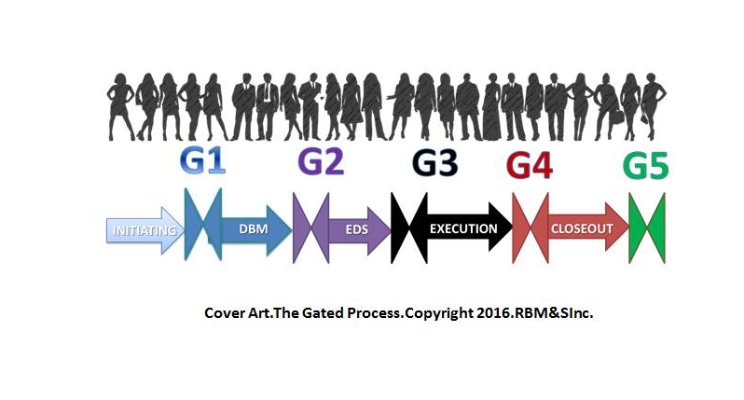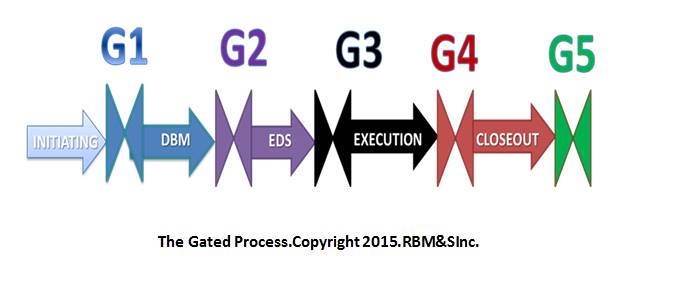
Project planning and scheduling processes follow a management framework called the Project Implementation Model (PIM). Such model divides the project into sub-boundaries called stages, gates, or checkpoints.
Does not really matter what proprietary term they call it. Company Y can call it Y-PIM (Company Y Implementation Model). Construction firm ABC might call theirs ABC-PIM.
Company ABC can call it any name because the name will not affect the framework’s gated process effectiveness.
What matter is this: the organization and its members understand the concept of the implementation model. The project team has to know what the stage deliverables are in order for the project to cross the gate successfully.
Mr. Just Saying (not his real name) expressed one of his pet peeves. Waving his hands in circle, he exclaimed in frustration,
“Believe me, many project members, from beginners to specialists, to senior leaders do not fully understand what the gated process is! During my various interactions in the last two decades, I have found and concluded that these people appear to know all yet they know a little more than nothing.”
He added, “They appear knowledgeable when they skim the surface but collapse completely when taken to deeper waters of understanding. Bottom line fact: they do not know the deliverables required at each gate. How can one provide directions without knowing what needs to be done?”
It is clear that the best way any project member should go about it is be honest. Ask questions and learn from those who really know because leading and directing without knowing is intellectual deceit.
Admitting that one has limited knowledge of the Gated process is far more morally acceptable than pretending.
There are a few ways to divide the project timeline into stages of say four to seven stages. A five (5) stage/gate project management framework is one of them.
Each stage represents a period allocated for the project to gather all information and materials that will qualify it to cross the control gate leading to the next stage (Figure 1).
Each division is a period of gradual development starting from zero to Gate 1 or the initiation, conception and development stage. The timeline from the beginning of the project to its first gate called Stage 1.
The project starts developing the basis of schedule in Stage 1. It is a planning document and a necessary input to schedule development. A schedule must have a plan to be believable.
Other organizations call Gate 1 as Checkpoint 1, Traffic Light 1, Gateway 1, or perhaps, Doorway 1. Many professed management experts continuously interchanged gates and stages. Do not be one of them!
Design-based memorandum stage follows. It is the period where concept selection and optimization occurs.
Engineering design specification leads to Gate 3 and subsequently the execution and commissioning stage leading to Gate 4.
The final stage is for final close out, post investment evaluation, investment review, and operability assessment. Unlike the early stages, the last stage uses highly defined information.
Figure 1 – Project Management Gated Process
The gated process is more of a guide than a standard, under a common frame of reference and understanding.
The reason for the guide concept is the fact that project is unique and must have enough elbowroom to be flexible, giving it the ability to tailor certain details distinctly relevant to the scope.
A framework with a rigid one-way philosophy and very prescriptive approach is impossible to implement.
Management frameworks and their gated process must have breadth and depth to be successful. It has to have visible support from management and overseen by a strong governance team. Although projects have the final call in the end, the guide provides the essential tools, techniques, and data to sift, group, sort, and pick the right decision.
Each responsible business process owner shall review the deliverable he is responsible for, listing problems, issues, findings, and observations. Be aware that project scope has a big influence on what is included in the list. The framework’s project implementation model defines documentation requirements.
The decision to pass the project through a gate is heavily dependent on the information available and provided at the time of review. This is why the gated process was also known as a “stage-limited commitment or creeping commitment (Wikipedia, 2017.Phase-Gate Model).
“The overall plan loses substance when important pieces are missing. It can also lose its essence when many smaller project elements are absent, through their cumulative effect. Data maturity is a project attribute project managers have to deal with in some intelligent way.
They seek to formulate a way to address missing and incomplete information, to strike a balance somehow. It is a threat trying to integrate a project with missing or incomplete work scope. Filling in an information space with assumed fill-in data is a risky trade-off (Frago, R., 2015.Wordpress.Retrieved from Risk-based Management: Data Maturity, Integration, Risk, and Execution).
The Gated process that lies within a project management framework demonstrates to all that a project (or any endeavor) has to start somewhere, sometime, with what is available in terms of resources and finally complete at the last stage.
When assumptions, fill-in information, and constraints are at it its peak, data maturity, and reliability are at their lowest ( ibid.).
One begins with an idea, feasibility study, business case, selecting alternative, optimizing selection, and detailing the plan and design, and executing the plan while pursuing the end-goal or group of objectives that can bring beneficial returns to the company.
Source:
Frago, R., (2016).Draft Manuscript\Plan to Schedule, Schedule to Plan. ISBN 978-0-9947608-2-1
Rufran C. Frago, PMP, P. Eng., PMI-RMP, CCP, Author (051717)

Related sites:
https://www.amazon.com/author/rufrancfrago
https://youtu.be/LDESPW6OYkg
Indigo/Chapters
Your World, Our Risk Universe: WordPress
LinkedIn Professional Website
Books authored by Rufran Frago
- Risk-based Management in the World of Threats and Opportunities: A Project Controls Perspective.ISBN 978-0-9947608-0-7.Canada
- Plan to Schedule, Schedule to Plan.ISBN 978-0-9947608-2-1.Canada
- How to Create a Good Quality P50 Risk-based Baseline Schedule.ISBN 978-0-9947608-1-4.Canada
- Schedule Quantitative Risk Analysis (Traditional Method).ISBN 978-0-9947608-3-8.Canada


